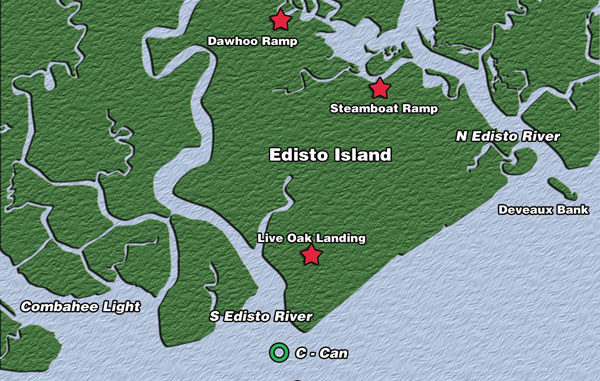
The rivers and estuaries around Edisto Island are full of summer sharks that offer hot action either way you look.
The only thing missing was the lonely ringing of the bell on the buoy marking the entrance to the South Edisto River. Otherwise, the anglers aboard the Marsh Hen, waiting at anchor, putting out a chum slick, could have been on board the Orca, waiting for a visit from the 20-foot great white shark of Jaws fame.
Had a big man-eater appeared, the trip would have ended immediately and this story would have been in the Newsbreakers section of the magazine. As it was, however, a 5½-foot blacktip showed up to play the part of the main character. The more-than-respectable fish made its way up the chum slick to find a lonely bluefish tethered under a balloon rig, and the fishermen had an idea something was afoot before it happened.
Capt. Jimmy Skinner called the fin when he saw it approximately 130 yards out. It wasn’t until the rod bent double and the reel started screaming that Skinner knew the fin had come to play. The shark went wherever it wanted, and it took a hard-fought, 45-minute battle before it made its first and surprisingly only pass alongside the boat.
“You better get pictures now, because I’m not putting this thing in the boat,” Skinner called over his shoulder
It was amazing that the fish made it to the boat at all, because after very little pressure on the frayed mono leader between the main line and the wire rig, the leader popped and the fish hung on the surface for a few seconds before slowly fining back to the depths.
“What do you say we rig up some light tackle now and do some sportfishing,” Skinner offered, a suggestion met with mutual agreement.
Contrary to popular opinion, sharks are not simply nomadic predators that show up in times of darkness and despair. Like any species, they have specific preferences and patterns, and to be catch them consistently, you need to understand what those patterns and preferences are.
A number of coastal shark species inhabit the waters around Edisto Island, including bonnethead, sandbar, scalloped hammerhead, finetooth, blacktip, Atlantic sharpnose, spinner, bull, blacknose, and the very occasional tiger shark.
“There’s a lot more of the bigger blacktips that move into this area in August and September, anywhere from four to six feet (long),” said Skinner, who charters for inshore and nearshore species from Fontaine Charters behind Edisto Seafood. “They come in here to birth their pups. Almost all of the big sharks will be pregnant females. There are so many baitfish in and around St. Helena Sound this time of year. It’s a huge estuary for baitfish, and the sharks come in here to feed.”
The most abundant of the Edisto sharks are Atlantic sharpnose and bonnethead. Sharpnose range from 10 inches up to four feet and weigh 10 or 12 pounds. They live in coastal waters nearly year-round, retreating offshore when temperatures get really cold and baitfish vacate the premises.
Bonnetheads bear a resemblance to and are cousins to hammerheads. They prefer warmer waters and are only present during the hottest months. Numerous bonnetheads can often be seen foraging along tidal rips next to shallow sandbars or points of a river tributary. They are bottom feeders who spend their time rooting in the sand for crabs and other crustaceans.
Rigging for bottom-feeding sharks such as bonnetheads, sharpnose and a variety of others is pretty simple. In fact, Skinner often incorporates bottom-fishing for sharks and bottom-fishing for bait using the same rigs. He prefers whole dead shrimp on a hand-tied mono rig. He uses 2/0 hooks on bottom-bouncer rigs anchored with 1- or 2-ounce pyramid sinkers. The take will include a mix of bonnethead, sharpnose, whiting, and small bluefish.
While the smaller sharks are great fun on light tackle, Skinner relishes any “white” fish for live bait and will rig a whiting or blue on a 124-pound Tooth Proof wire rig that includes a 7/0 main hook and a 4/0 treble hook as a stinger. A section of 150-pound mono shock leader is tied between the wire rig and the main line, which is 80-pound braid. Stringing the “J” hook through the nose of the bait and the stinger in its tail, Skinner ties a small, softball-shaped balloon to the far end of the shock leader and floats the bait out with the tide.
“Most days, the big sharks are cruising just below the surface, and the live bait kicking around gets their attention,” said Skinner. “Other times, they hang on the bottom. That’s why I’ll also throw out a cable rig for bottom fishing that has a 6/0 circle hook and a 3-ounce pyramid sinker.”
According to Skinner, the best bait for bonnetheads is half of a blue crab fished on the bottom near a sandbar tidal rip or in the eddies of a long point near a river. He prefers an incoming tide for any type of shark fishing but says an outgoing tide works well, too. Moving water is necessary for shark fishing, especially the shallow-water feeders.
“Bonnetheads are a little different when it comes to water depths they prefer,” he said. “They will cruise the shoals, especially around the outer islands, and will come cruising by in large numbers with their fins out of the water. It’s not unusual to sight cast to them and watch them fight over which one is going to eat the bait.”
Sharking on the south side of Edisto Island centers on the South Edisto River. Skinner likes the mouths of any tributary that empties into the South Edisto, concentrating on deep, scour holes created by the current. Far and away, however, his preference is the entrance of the South Edisto itself, out to his favorite hole which he calls the “B Can.”
“There are several good spots around the mouth of the South Edisto,” Skinner said. “You have the B-Can, which is about four miles off the beach where the channel cuts between bars. The C-Can is also just about as good and closer in. Due west of the B-Can is a long sandbar that runs parallel to the South Edisto. There’s 15 to 20 feet of water on the outside, and bluefish cruise up and down the bar, hence the name ‘Bluefish Bar,’ but it’s also a great place to catch sharks.”
Similar locations can be found on all sides of St. Helena Sound, which lies south of the South Edisto. Another of Skinner’s favorite spots is Combahee Light on the west side of Otter Island at the mouth of the Ashepoo River. A flashing navigational marker marks a sheer ledge that drops from 12 to 40 feet.
Swinging around to the other end of the island, Capt. Chris Chavis of Fin Stalker Charters says there’s plenty of deep water for anglers interested in chasing big fins. If bonnies are your target, he recommends a number of shallow shoals along the North Edisto.
“Right across from Bohicket Creek is a long, flat shoal that almost always holds bonnetheads this time of year,” Chavis said. “You can also catch them in the shallow waters on either side of the bar at Deveaux Bank, which lies in the mouth of the North Edisto.”
Chavis also has some inshore areas that are known to hold some big sharks.
“The mouth of Privateer Creek has a deep hole that goes down to 75 feet. You can cut big baits and send them all the way to the bottom. Several years back, we caught a tiger shark out of that hole that went well over 300 pounds,” he said.
One of Chavis’ most interesting shark adventures is chasing the shrimp boats that troll just off the coast during summer. The commotion of the nets and discarded by-catch is a magnet for sharks. The most important thing is to keep your distance, you don’t want to get tangled up in a shrimp net or interfere with the boat’s work.
“You can slip in after the boat passes and usually sight-fish big sharks,” said Chavis. “They love to follow the shrimpers, plus, you’re likely to tangle with some really big sharks.”

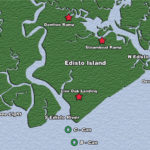
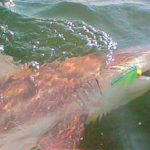
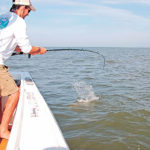
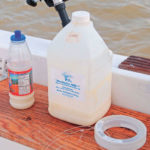
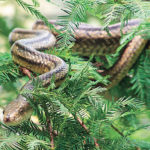
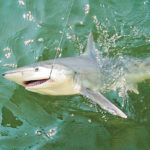



Be the first to comment